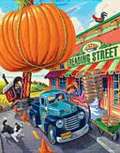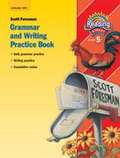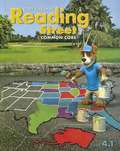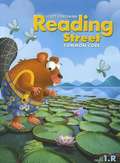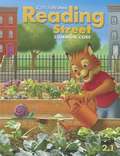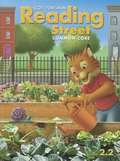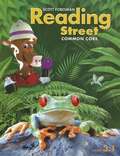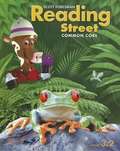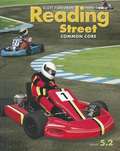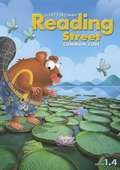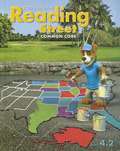- Table View
- List View
Reading Street [Grade 5]
by Candy Dawson Boyd Sharon Vaughn Camille Blachowicz Wendy Cheyney Connie Juel Edward Kame'Enui Donald Leu Jeanne Paratore Sam Sebesta Deborah Simmons Susan Watts-Taffe Karen Kring Wixson Peter Afflerbach P. David PearsonNIMAC-sourced textbook
Reading Street [Grade 5]
by Candy Dawson Boyd Sharon Vaughn Camille Blachowicz Wendy Cheyney Connie Juel Edward Kame'Enui Donald Leu Jeanne Paratore Sam Sebesta Deborah Simmons Susan Watts-Taffe Karen Kring Wixson Peter Afflerbach P. David PearsonNIMAC-sourced textbook
Reading Street [Grade 5]
by Candy Dawson Boyd Sharon Vaughn Camille Blachowicz Wendy Cheyney Connie Juel Edward Kame'Enui Donald Leu Jeanne Paratore Sam Sebesta Deborah Simmons Susan Watts-Taffe Karen Kring Wixson Peter Afflerbach P. David PearsonAs you read selections in Reading Street about ghost towns, blues singers, and insects that swell up to store food, you will gain exciting new information that will help you in science and social studies. While you're enjoying these exciting pieces of literature, you will find that something else is going on--you are becoming a better reader, gaining new skills and polishing old ones.
Reading Street [Grade 5]
by Candy Dawson Boyd Camille Blachowicz Peter AfflerbachNIMAC-sourced textbook
Reading Street [Grade 5] Oregon
by Candy Dawson Boyd Sharon Vaughn Camille Blachowicz Wendy Cheyney Connie Juel Edward Kame'Enui Donald Leu Jeanne Paratore Sam Sebesta Deborah Simmons Susan Watts-Taffe Karen Kring Wixson Peter Afflerbach P. David PearsonNIMAC-sourced textbook
Reading Street [Grade 6.1]
by Candy Dawson Boyd Sharon Vaughn Camille Blachowicz Connie Juel Edward Kame'Enui Donald Leu Sam Sebesta Deborah Simmons Karen Kring Wixson Peter Afflerbach P. David Pearson Jeanne R. Paratore Elena Izquierdo Alfred Tatum Susan Watts TaffeNIMAC-sourced textbook
Reading Street [Grade 6.2]
by Candy Dawson Boyd Sharon Vaughn Camille Blachowicz Connie Juel Edward Kame'Enui Donald Leu Sam Sebesta Deborah Simmons Karen Kring Wixson Peter Afflerbach P. David Pearson Jeanne R. Paratore Elena Izquierdo Alfred Tatum Susan Watts TaffeScott Foresman Reading Street (c) 2011 is an all-new comprehensive Reading and Language Arts series for the 21st Century. Reading Street delivers classic and soon-to-be classic literature, scientifically research-based instruction, and a wealth of groundbreaking online experiences for high student engagement. My Teaching Library takes the guesswork out of Response to Intervention with a strong core emphasis on ongoing progress-monitoring and an explicit plan for managing small groups of students. The architecture of Understanding by Design accelerates all learners, especially English language learners, toward greater proficiency with a sustained Unit focus on concepts and language. Learn more.
Reading Street [Grade 6]
by Candy Dawson Boyd Sharon Vaughn Camille Blachowicz Wendy Cheyney Connie Juel Edward Kame'Enui Donald Leu Jeanne Paratore Sam Sebesta Deborah Simmons Susan Watts-Taffe Karen Kring Wixson Peter Afflerbach P. David PearsonNIMAC-sourced textbook
Reading Street [Grade 6]
by Candy Dawson Boyd Sharon Vaughn Camille Blachowicz Wendy Cheyney Connie Juel Edward Kame'Enui Donald Leu Jeanne Paratore Sam Sebesta Deborah Simmons Susan Watts-Taffe Karen Kring Wixson Peter Afflerbach P. David PearsonNIMAC-sourced textbook
Reading Street, Grade 5: Grammar and Writing Practice Workbook
by Scott ForesmanThis companion workbook to the Grammar & Writing text gives additional practice problems and test preparation.
Reading Street: Common Core, 1.1
by Candy Dawson Boyd Sharon Vaughn Camille Blachowicz Connie Juel Donald Leu Sam Sebesta Deborah Simmons Karen Kring Wixson Peter Afflerbach P. David Pearson Jeanne R. Paratore Elena Izquierdo Alfred Tatum Susan Watts Taffe Edward KaméenuiNIMAC-sourced textbook
Reading Street: Common Core, 1.2
by Candy Dawson Boyd Sharon Vaughn Camille Blachowicz Connie Juel Donald Leu Sam Sebesta Deborah Simmons Karen Kring Wixson Peter Afflerbach P. David Pearson Jeanne R. Paratore Elena Izquierdo Alfred Tatum Susan Watts Taffe Edward KaméenuiNIMAC-sourced textbook
Reading Street: Common Core, 1.3
by Candy Dawson Boyd Sharon Vaughn Camille Blachowicz Connie Juel Donald Leu Sam Sebesta Deborah Simmons Karen Kring Wixson Peter Afflerbach P. David Pearson Jeanne R. Paratore Elena Izquierdo Alfred Tatum Susan Watts Taffe Edward KaméenuiNIMAC-sourced textbook
Reading Street: Common Core, 1.R
by Candy Dawson Boyd Sharon Vaughn Camille Blachowicz Connie Juel Donald Leu Sam Sebesta Deborah Simmons Karen Kring Wixson Peter Afflerbach P. David Pearson Jeanne R. Paratore Elena Izquierdo Alfred Tatum Susan Watts Taffe Edward KaméenuiNIMAC-sourced textbook
Reading Street: Common Core, 2.1
by Candy Dawson Boyd Sharon Vaughn Camille Blachowicz Connie Juel Donald Leu Sam Sebesta Deborah Simmons Karen Kring Wixson Peter Afflerbach P. David Pearson Jeanne R. Paratore Elena Izquierdo Alfred Tatum Susan Watts Taffe Edward KaméenuiNIMAC-sourced textbook
Reading Street: Common Core, 2.2
by Candy Dawson Boyd Sharon Vaughn Camille Blachowicz Connie Juel Donald Leu Sam Sebesta Deborah Simmons Karen Kring Wixson Peter Afflerbach P. David Pearson Jeanne R. Paratore Elena Izquierdo Alfred Tatum Susan Watts Taffe Edward KaméenuiNIMAC-sourced textbook
Reading Street: Common Core, 3.1
by Candy Dawson Boyd Sharon Vaughn Camille Blachowicz Connie Juel Donald Leu Sam Sebesta Deborah Simmons Karen Kring Wixson Peter Afflerbach P. David Pearson Jeanne R. Paratore Elena Izquierdo Alfred Tatum Susan Watts Taffe Edward KaméenuiNIMAC-sourced textbook
Reading Street: Common Core, 3.2
by Candy Dawson Boyd Sharon Vaughn Camille Blachowicz Connie Juel Donald Leu Sam Sebesta Deborah Simmons Karen Kring Wixson Peter Afflerbach P. David Pearson Jeanne R. Paratore Elena Izquierdo Alfred Tatum Susan Watts Taffe Edward KaméenuiNIMAC-sourced textbook
Reading Street: Common Core, 6.1
by Candy Dawson Boyd Sharon Vaughn Camille Blachowicz Connie Juel Donald Leu Sam Sebesta Deborah Simmons Karen Kring Wixson Peter Afflerbach P. David Pearson Jeanne R. Paratore Elena Izquierdo Alfred Tatum Susan Watts Taffe Edward KaméenuiNIMAC-sourced textbook
Reading Street: Common Core, Grade 5. 2
by Scott Foresman and CompanyReading Street: Common Core, Grade 5.2
Reading Street: Common Core, [1.4]
by Candy Dawson Boyd Sharon Vaughn Camille Blachowicz Connie Juel Donald Leu Sam Sebesta Deborah Simmons Karen Kring Wixson Peter Afflerbach P. David Pearson Jeanne R. Paratore Elena Izquierdo Alfred Tatum Susan Watts Taffe Edward KaméenuiNIMAC-sourced textbook
Reading Street: Common Core, [1.5]
by Candy Dawson Boyd Sharon Vaughn Camille Blachowicz Connie Juel Donald Leu Sam Sebesta Deborah Simmons Karen Kring Wixson Peter Afflerbach P. David Pearson Jeanne R. Paratore Elena Izquierdo Alfred Tatum Susan Watts Taffe Edward KaméenuiNIMAC-sourced textbook

